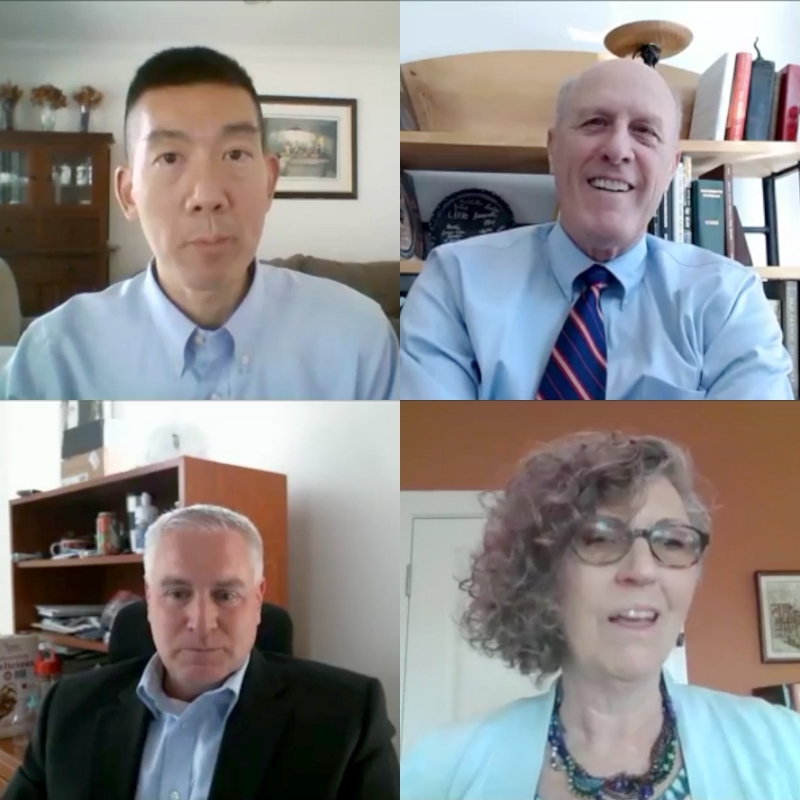October 2020
For many in the University of Maryland, Baltimore (UMB) community who are working remotely during the coronavirus pandemic, the pace of developments relating to the disease, our understanding of it, and measures to counter its impact may seem slow, but the reality is that things are moving incredibly fast.
Even so, the approach of colder weather has many concerned about a second surge in COVID-19 cases. “Right now, I think it’s an uneasy lull,” explained Wilbur Chen, MD, MS, professor in the University of Maryland School of Medicine (UMSOM) and an infectious disease expert. “I think we need to be prepared that there will be a resurgence.”
Speaking on the Oct. 8 edition of Virtual Face to Face with Dr. Bruce Jarrell, the weekly web-based program hosted by UMB President Bruce E. Jarrell, MD, FACS, Chen was joined by two other UMB experts, Marianne Cloeren, MD, MPH, UMSOM associate professor, with a specialty in occupational and environmental health; and Steven Deck, DM, MBA, director, Department of Environmental Health and Safety.

(clockwise from top left: Wilbur Chen, MD, MS; Bruce Jarrell, MD, FACS; Marianne Cloeren, MD, MPH; and Steven Deck, DM, MBA)
The discussion took place 211 days after the World Health Organization declared the COVID-19 outbreak a pandemic. Since that time the disease has spread rapidly, although not evenly, around the world, infecting more than 35 million and taking more than a million lives.
Scientists’ understanding of SARS-CoV-2 (the virus that causes the disease COVID-19) has grown as well. Our understanding of how the disease works has grown tremendously. We know much more about how it’s transmitted, and what works best to prevent transmission. Our list of diagnostic symptoms has grown. We have a greater understanding of the long-term effects after recovery. And we’ve determined some of the treatments that appear to help bolster the immune system so it can fight the virus or to combat the immune system’s often powerful and damaging overreaction to the virus.
During President Donald Trump’s recent stay at Walter Reed National Military Medical Center, he received a trifecta of therapeutics: the anti-viral Remdesivir, the steroid Dexamethazone, and an experimental monoclonal antibody cocktail.
Most amazing, of course, is that the progress toward developing an effective vaccine has shattered all expectations, with at least 11 vaccine candidates now engaged in human trials.
Apart from medicine, our lives, jobs, and university have changed, too. Schools and universities have closed, and opened, and closed — in different combinations. Research came to a near halt at UMB and has restarted in phases. Acceptance of remote teaching and learning seems to be on the rise. And individuals, teams, even whole departments are doing what used to be unthinkable for any appreciable amount of time: working from home, often more productively.
And then, of course, there are all the things we do to stay safe. In March, at the beginning of the pandemic, the best medical advice was to apply traditional respiratory virus countermeasures — hand washing, avoiding touching our faces, and so forth. Now, in addition to wearing masks at all times on campus, UMB has an elaborate system — SAFE on Campus — to monitor and track symptoms and trace contacts where needed.
During the Face to Face discussion, audience members asked about predictions of a fall surge in COVID-19 cases, the latest thinking on viral transmission, the timeline of vaccine development, and much more. Watch the entire program at the link above.
Search UMB News
Sign up for UMB Alerts.



